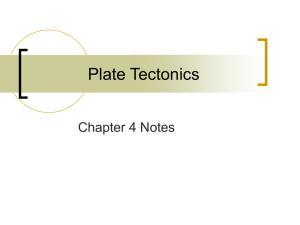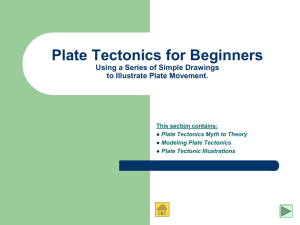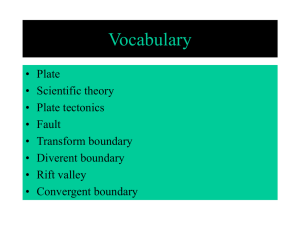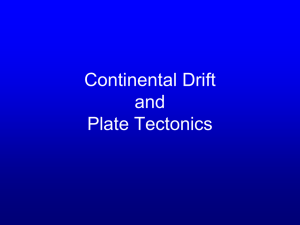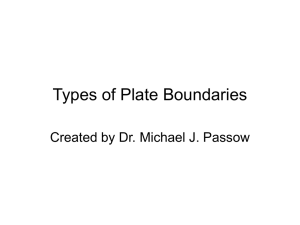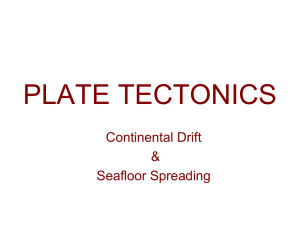Lecture 4
advertisement
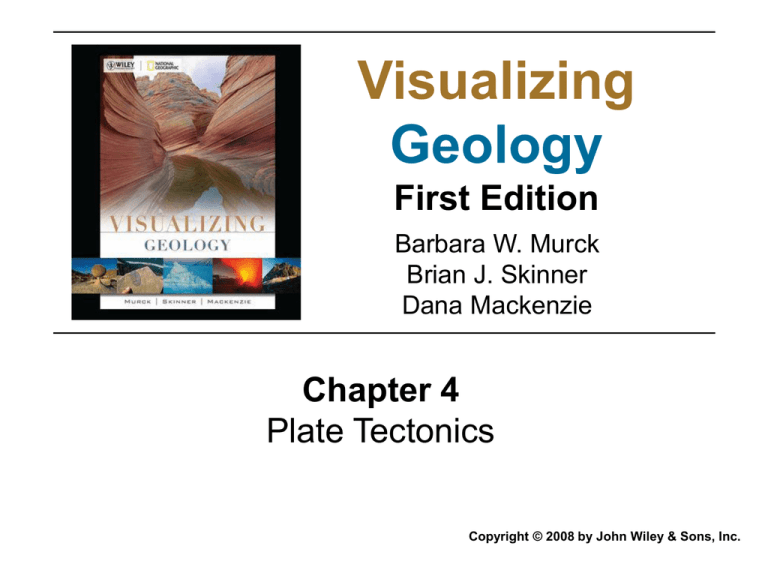
Visualizing Geology First Edition Barbara W. Murck Brian J. Skinner Dana Mackenzie Chapter 4 Plate Tectonics Copyright © 2008 by John Wiley & Sons, Inc. Located in the Himalayan Mountain Range, on the border of China and Nepal, the peak of Mount Everest is the highest point on earth. It towers 29,028 feet (8,848 meters) above sea level. Located in the Pacific Ocean, just southeast of the Mariana Islands, Mariana Trench is the deepest point on earth. At 35,798 feet (11,932 meters) below sea level, Mariana Trench is farther below sea level than Mt. Everest is above it. At the bottom of the Mariana Trench, water exerts a pressure of over a thousand times that of standard atmospheric pressure at sea level. Scientific revolutions challenge us to look at the world in a new way. Just like in 1543 when Nicolaus Copernicus argued that the planets revolved around the Sun and he was called mad and eccentric, and later when Galileo tried to defend this heliocentric argument, Galileo was tormented and arrested until the day of his death. In the 1960’s geology had a big revolution when geologists discovered new evidence for a 50 year old idea called continental drift. Just like the Copernicus'' theory the hypothesis that continents move provoked a great controversy. Wegener’s theory of continental drift In 1912, a German meteorologist named Alfred Wegener had the idea that all the continents were joined together in a single “supercontinent” called Pangea, which means “all lands”. He also suggested that Pangea had split into fragments like pieces of ice floating on a pond and that the continental fragments had slowly drifted to their present locations. Continental drift – The slow, lateral movement of continents across the surface. Wegener although he had marshalled a good deal of evidence couldn’t explain the mechanism that would move the continents. The puzzle piece argument Matching geology Matching fossils In 1915 Alfred Wegener drew a map much like this one, showing the distribution of continents 300 mya. What is the “true” edge of a continent? How well do continents fit? How well do the ages match? Mountain belts that are similar What evidence did glaciers leave? Glaciers evidence, South Africa Similar fossils of Glossopteris have been found in Africa, India, Australia and South America. Similar fossils of Glossopteris have been found in Africa, India, Australia and South America. Apparent polar wandering paths Wegener gather evidence but other scientists were still unconvinced. In 1950, paleomagnetism emerged as a new tool. Remember that when magma solidifies the iron bearing minerals become magnetized and take the polarity of the Earth at that time. In the 1950’s geophysicists found out about a phenomenon called apparent polar wandering. The missing clue: sea floor spreading In the 1960s many clues have amazed to support the theory of continental drift. Seafloor spreading – The processes through which the seafloor splits and moves apart along a mid-ocean ridge, and new oceanic crust forms along the ridge. The symmetrical pattern of magnetic bands provided powerful support for hypothesis, fist proposed in 1960, called seafloor spreading. The decisive piece of evidence for seafloor spreading is that the ages of seafloor rocks increase with distance from the ridge. Recently we have access to even a more profound piece of evidence with the use of GPS. GPS also confirmed estimated movement velocities that vary from 1 to 10 cm a year. The extreme environment of the mid-ocean ridge Measuring plate motion using GPS Plate Tectonics and the Scientific Method The development of the plate tectonic theory serves as an excellent example of the scientific method. The scientific method is a series of steps that can lead to the discovery of new scientific principles. The steps are: 1) Gathering a set of observations or measurements (a data set) from natural phenomena or experiments. 2) Formulating one or more hypotheses to explain the observations or data. The hypotheses can be conceptual, physical, or mathematical. A hypothesis is unproved and must be testable. Plate Tectonics and the Scientific Method 3) Making a set of predictions using the hypothesis. The predictions are then tested. If the predictions are correct, the hypothesis gains credibility. If the predictions are incorrect, the hypothesis must be modified or abandoned. The hypothesis is modified and retested many times before they can account for all the data. 4) Gaining the status of a theory after being tested by new experimental advances. A theory is a generally accepted explanation for a set of data or observations. Plate Tectonics and the Scientific Method How does the development of plate tectonics follow the scientific method? Wegener gathered sets of observations on the distribution of rock types, fossils, glaciation, and climate zones. He searched for a common explanation to relate these diverse features and phenomena. Wegener hypothesized that the present-day continents were in different positions in the geologic past. By reassembling the continents into a single supercontinent, he explained the distribution of rock types, glaciation, and fossils. The drift of the continents over the surface of the Earth with time explained the distribution of climate zones. Plate Tectonics and the Scientific Method Wegener also proposed that continents plowed through oceanic crust. However, other geologists knew this to be impossible because of the strength of rock. Wegener's hypotheses, although satisfactory in many respects, could not explain all the observations. It was not until new methods of testing continental drift (and sea floor spreading) were introduced that plate tectonics gained acceptance. For example, it was predicted that the age of rocks increased away from mid-ocean ridges. Dating methods for rocks proved this prediction true. Plate Tectonics and the Scientific Method Plate tectonics has been rigorously tested from numerous subdisciplines in geology. Most geologists accept these tests as verification of plate tectonics. Successful testing and widespread acceptance elevates plate tectonics from a hypothesis to a theory. Plate Tectonics and the Scientific Method Plate Tectonics and the Scientific Method ATLANTIDA? LEMURIA? LIFE ON MARS? HOLLOW EARTH, SUBTERRANEAN CIVILIZATIONS? EXTRATERRESTRIALS? GHOSTS? What were the arguments that Wegener gave in favor of his hypothesis of continental drift? What further evidence for continental drift was discovered after Wegener’s death? What is Pangea? What is seafloor spreading? How does seafloor spreading create paleomagnetic bands? How quickly do continents move, and how do we know? The plate tectonic model Plate tectonics – the movement and interactions of large fragments of Earth’s lithosphere, called plates. After the proposition of the theory of Plate Tectonics geologist now could explain the forces behind mountain building and the formation of ocean trenches. Note that we call it a theory rather than a hypothesis. A hypothesis is a tentative explanation, whereas a theory is an explanatory model that is supported by a lot of scientific evidence. Plate tectonics in a nutshell The Earth’s lithosphere or rocky outer layer, very thin relative to the Earth as a whole. The solid rock of the lithosphere lies on top of a vast mantle, made of hotter and weaker material that is constantly in a very slow motion. The layer directly below the lithosphere is called the asthenosphere, the relationship between these two layers is called isostasy, which means literally that the lithosphere is “floating” onto the asthenosphere. Plate tectonics in a nutshell Driven in part by the underlying motion of the asthenosphere, these plates collide, split apart, and slide past one another. This generates a lot of geologic activity, such as earthquakes and mountain building. The boundaries of these plates are marked by huge fractures called faults. Fault – A fracture in Earth’s crust along which movement has occurred. Types of plate margin – Divergent margin – A boundary along which two plates move apart from one another. Convergent margin – A boundary along which two plates come together. Transform fault – A fracture in the lithosphere where two plates slide past each other. Subduction zone – A boundary along which one lithospheric plate descends into the mantle beneath another plate. Earthquakes and plate margins Earthquakes occur along faults where huge blocks of rocks are grinding past each other. The movement is rarely smooth: usually blocks tick because of friction, when the friction is overcome the blocks slip abruptly, releasing energy with a huge snap – an earthquake. The location beneath the surface where the earthquake begins is called the focus, this should not be confused with the epicenter which is the point on the surface of the Earth that lies directly over the focus. In search for a mechanism What exactly drives the plates motion? How does the mantle interact with the crust? What initiates subduction? Thermal motion is at least partially responsible for the motion of the plates. Earth’s internal heat – Earth gives off heat for two main reasons. First the slow cooling from its initial formation process and second heat is being constantly generated by the decay of radioactive elements. Convection as a driving force – Convection – A form of heat transfer in which hot material circulates from hotter to colder regions, loses its heat and then repeats the cycle. Tectonic cycle – Movements and interactions in the lithosphere, by which rocks are cycled from the mantle to the crust and back, includes earthquakes, volcanism, and plate motion, driven by convection in the mantle. What is the motor behind the theory of plate tectonics? Why has the Earth’s lithosphere broken into plates? How have geologists determined the shapes of Earth’s plates? What are the different types of plate margins? Explain why different kinds of plate margins are susceptible to different kinds of earthquakes Where is new seafloor formed? Where is old seafloor recycled? The Hawaiian Islands – In 1840 a geologist named J D Dana noticed the increasing ages of the islands from southeast to northwest. The Hawaiian Islands – The Kilauea volcano added new land. Just 15 km south of Hawaii a new island has been born. The Hawaiian Islands – Loihi seamount is an underwater volcano that is about 1km under water and growing everyday. Mini version of plate tectonics form by a volcanic eruption in Hawaii. Can you spot a convergent margin, a divergent margin, and a transform fault that joins two divergent margins. Mini version of plate tectonics form by a volcanic eruption in Hawaii. Can you spot a convergent margin, a divergent margin, and a transform fault that joins two divergent margins. What is the name that Wegener gave to the super continent? Give some examples that support the idea of continental drift. What is polar wandering? Name the three types of plate interaction. What is the name of a recent technology that allowed scientists to measure the movement of continental crust? According to this illustration, where are the oldest rocks located and the youngest? Draw an arrow that determines the direction of movement of the plate over the hot spot. What is the explanation of why do plates move? What is convection? What is a subduction zone? Label the following block diagrams. The idea proposed by Alfred Wegener to explain the continental shapes and positions is known as _____. A) Pangaea B) plate tectonics C) continental drift D) rift valley E) sea floor spreading According to Wegener's model, what evidence did glaciers leave for the existence of Pangaea? A) striations B) glacial lakes C) fossils D) soil deposits E) ice In the diagram below, which two are the best examples of different continental positions in the past? A) North America – South America B) North America – Africa C) South America – Asia D) Europe – North America E) South America – Africa What was the name of the floral fossils Wegener used for the idea of continental drift? A) B) C) D) E) Mesosaurs trilobites Glossopteris Pseudoschwagerina oak In the figure below, what is the age of the sea floor off of the Bahamas? A) younger than 9.6 million years B) 9.6 – 33.0 million years C) 33.0 – 83.0 million years D) 83.0 – 141.9 million years E) older than 141.9 million years In the figure below, what is the approximate age of the sea floor off the north coast of Spain? A) younger than 9.6 million years B) 9.6 – 33.0 million years C) 33.0 – 83.0 million years D) 83.0 – 141.9 million years E) older than 141.9 million years Which of the following terms best describes the rocky outer layer of the Earth? A) athenosphere B) biosphere C) atmosphere D) lithosphere E) hydrosphere Which type of plate boundary results from two or more plates coming together? A) convergent B) divergent C) transform D) hot spot E) ridge What is the depth of the newly forming Hawaiian island, Loihi? A) about 1000m B) about 2000m C) about 3000m D) about 4000m E) it is at the surface According to the figure below, which of the following types of plate boundaries produce the deepest earthquakes? A) transform fault boundary B) divergent boundary C) continental collision boundary D) subduction zone boundary E) all the same According to the figure below, which of the following types of plate boundaries produce the shallowest earthquakes? A) transform fault boundary B) divergent boundary C) continental collision boundary D) subduction zone boundary E) all the same What term best describes to driving force behind plate tectonics? A) expansion B) convergence C) convection D) divergence E) transformation The phenomenon of the Earth's magnetic pole being in different locations in the past is known as _______. A) convection B) sea floor spreading C) normal polarity D) reverse polarity E) apparent polar wandering In the figure below, how many magnetic reversals occurred between 2.0 and 1.5 million years ago? A) 1 B) 2 C) 3 D) 4 E) 0 In the figure below, how many magnetic reversals occurred between 1.5 million years and present? A) 1 B) 2 C) 3 D) 4 E) 0 According to the diagram below, which of the following plates is all oceanic crust? A) North America B) Africa C) Nasca D) South America E) Eurasian According to the diagram below, which of the following is the largest plate? A) Pacific B) Africa C) Nasca D) South America E) Eurasian According to the figure below, most of eastern Brazil is approximately how old? A) older than 500 million years B) about 550 million years C) younger than 550 million years D) older than 1 billion E) none of the above According to the figure below, the island of Molokai was probably over the hot spot approximately how many million years ago? A) 0.8 B) 1.0 C) 1.30 D) 2.9 E) 3.2 True/False Pangaea is the name of the supercontinent proposed by Harry Hess. The Hawaiian Islands are a result of the Pacific Plate passing over a hot spot. A hypothesis is a scientific theory that has been tested. The area of the Earth's interior where rocks start to melt is known as the asthenosphere. Rocks closer to the spreading centers in the oceans are older than the rocks farther away from the spreading center. True/False Global positioning systems (GPS) are a reliable way to measure plate movements. Obduction is the processes where one plate slides under another. “Black smokers” are chimneys on the sea floor that release superheated gases. Theories are able to be proved with scientific evidence. Fill in the blank The transform plate margin found in the western United States is characterized by the _______ fault. Fill in the blank The rocky, outermost part of the Earth, comprising the upper part of the mantle and the crust, is known as the _______. The reptilian fossils that Wegener used to help prove his ideas about plates are known as _______. The process in which the sea floor separates and moves in opposite directions is known as _______. The exact point where an earthquake occurs below the surface is the _______. The rate at which plates move apart is approximately 1 to 10 cm/year. (true/false) Fill in the blank The point on the surface directly above an earthquake occurrence is called the _______. The process of one plate diving under another plate is known as _______. Short essay How does a convergent plate boundary differ from a divergent plate boundary? How do paleomagnetic stripes on the sea-floor support seafloor spreading? Short essay How did the presence of Glossopteris fossils support Wegener's idea of continental drift? Why are earthquake foci depths associated with transform plate boundaries fairly shallow? How does the global distribution of earthquakes relate to the plate boundaries? Describe the evidences Wegener used to reconstruct Pangaea. Describe the Plate Tectonic model. Short essay Why are volcanoes not present with all types of plate boundaries? Briefly explain how convection drives plate motion.

